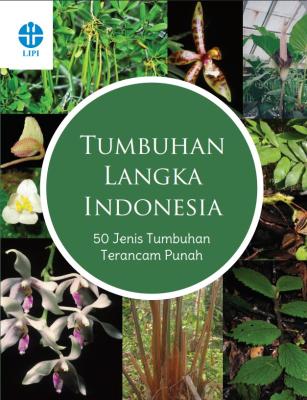Tumbuhan Langka Indonesia: 50 Jenis Tumbuhan Terancam Punah
Keywords:
Tumbuhan, Langka, IndonesiaSynopsis
Buku ini merupakan lanjutan dari Seri Panduan Lapangan Tumbuhan Langka Indonesia karya Johanis P. Mogea dkk. Buku ini menyajikan informasi komprehensif mengenai jenis-jenis tumbuhan asli Indonesia yang jumlah populasinya sudah sangat sedikit dan termasuk di dalam daftar kelangkaan IUCN. Seri lanjutan ini memuat lebih banyak jenis tumbuhan dari seri sebelumnya, dengan informasi pertelaan yang semakin detail serta dilengkapi dengan pembudidayaan dan tindakan pelestarian yang telah diambil. Oleh karena itu, buku ini sangat tepat dibaca bagi para pengambil keputusan di instansi terkait untuk menentukan arah kebijakan konservasi di Indonesia. Juga bagi dosen dan mahasiswa serta seluruh pegiat konservasi tumbuhan di Indonesia, buku ini merupakan sumber informasi yang berharga.
Downloads
References
Adie, H. H. (1978). Ferns of Hong Kong. Hong kong: Hong Kong University Press.
Amarasingham, R. D., Bisset, N. G., Millard, A. H., & Woods, M. C. (1964). A phytochemical survey of Malaya part III. Alkaloids and saponins. Economic Botany, 18(3), 270–278.
Ardiyani, M., Anggara, A., & Leong-S?kornic?kova?, J. (2011). Rediscovery of Curcuma sumatrana (Zingiberaceae) endemic to West Sumatra. Blumea, 56, 6–9.
Argent, G., Saridan, A., Campbell, E. J. F., Wilkie, P., Fairweather, G., Hadiah, J. T., Yulita, K. S. (1997). Manual of the larger and more important non- Dipterocarp trees of Central Kalimantan. Vol. 1 & 2. Samarinda: Forest Research Institute Samarinda-ODA ITFMP.
Ari ani, D. (2010). Newly recorded species of Endiandra R.Br. (Lauraceae) from Waigeo Island, Raja Ampat, Papua, Indonesia. Garden’s Bulletin Singapore, 62(1), 23–30.
Ashton, P. S. (1982). Dipterocarpaceae. Flora Malesiana I, 9(2), 237–552. Backer, C. A., & Van den Brink Jr., B. (1965). Flora of Java II. Groningen:
Noordrof.
Beccari, O. (1933). Asiatic palms—Corypheae. Annals of the Royal Botanic
Garden Calcutta, 13, 1–356.
Brown, N. E. (1882). Curcuma sumatrana Miq. Gardeners’ Chronicle XVIII:
Burkill, I. H. (1935). A dictionary of the economic products of the Malay Peninsula. London: Crown Agents for the Colonies Millbank.
Cheek, M., & Jebb, M. (2001). Nepenthaceae. Flora Malesiana I, 15, 163. Chin, S. C. (1979). e limestone hill ora of Malaya II. e Gardens’ Bulletin
of Singapore, 32, 103.
Clarke, C. (1997). Nepenthes of Borneo. Kota Kinabalu, Sabah: Natural
History Publications.
Comber, J. B. (1990). Orchids of Java. Kew: Bentham-Moxon Trust, Royal
Botanic Gardens.
Dan, Ng. V., & Nhu, D. T. (1989). Medicinal plants in Vietnam. New York:
World Health Organization.
Hou, D. (1978). Anacardiaceae. Flora Malesiana I, 8(3), 431.
Drans eld, J., Uhl, N. W., Asmussen, C. B., Baker, W. J., Harley, M. M., &
Lewis, C. E. (2008). Genera palmarum: e evolution and classi cation
of palms. Kew: Royal Botanic Garden.
Drans eld, J., & Manokaran, N. (1993). Rattans. Prosea 6. Wagenigen: Prosea
Project.
Dressler, R. L. (1993). Phylogeny and classi cation of the orchid family.
Flowering Plants, 9(2), 237–552.
Hartini, S. (2003). Cibotium barometz (L.) J. Sm. Tumbuhan obat yang sudah
langka. Warta Kebun Raya, 3(2), 19–25.
Hetterscheid, W., & Ittenbach, S. (1996). Everything you always wanted to
know about Amorphophalus, but were afraid to stick your nose into!!!
Aroideana, 19, 59–70.
Heyne, K. (1979). Tumbuhan berguna Indonesia. Jilid III. Jakarta: Yayasan
Sarana Wana Jaya.
Heyne, K. (1987). Tumbuhan berguna Indonesia. Jilid II. Jakarta: Yayasan
Sarana Wana Jaya.
Holttum, R. E. (1963). Ferns of Malaya. Flora of Malaya. Vol. II. Singapura:
Government Printing O ce.
Holttum, R. E. (1950). e Zingiberaceae of the Malay Peninsula. Garden’s
Bulletin Singapore, 8, 1–249.
Hughes, M., & Girmansyah, D. (2011). Searching for Sumatran Begonia
described by William Jack: Following in the footsteps of a 19th century Scottish botanist. Gardens’ Bulletin Singapore, 63(1 & 2), 83–96.
Isnaini, Y., & Praptosuwiryo, T. N. (2015). Kultur spora in vitro tiga varian pakis simpei. Prosiding Seminar Nasional Masyarakat Biodiv. Ind., 1 (7), 1649–1653.
IUCN. (2013). e IUCN red list of threatened species. Version 2013.2. Diunduh pada 21 November 2013 dari http://www.iucnredlist.org.
Jansen, P. C. M. (1999). Minor Essential-oil Plants In Oyen, L.P.A. & Nguyen Xuan Dong (Eds.): Prosea, No. 19. Essential-oil Plants. Bakhyus Publishers, Leiden, Belanda. 173–186.
Kalima, T. (2014). Potensi jenis Dipterocarpus retusus Blume di Kawasan Hutan Situ Gunung Sukabumi. Buletin Plasma Nutfah, 19(2), 102. Badan Penelitian dan Pengembangan Pertanian, Departemen Pertanian.
Keng, H. (1978). Orders families Malayan seed plants. Singapura: Singapore University Press.
Kessler, P. J. A., & Sidiyasa, K. (1994). Trees of the Balikpapan-Samarinda area, East Kalimantan, Indonesia. Wageningen, Belanda: e Tropenbos Foundation.
Kiew, R. (2005). Begonias of Peninsular Malaysia. Sdn. Bhd., Kota Kinabalu, Sabah, Malaysia: Natural History Publications (Borneo).
Koorders, S. H. (1898). Flora van N.O. Celebes. Jakarta: ’Gravenhage G. Kol dan Co.
Koorders, S. H. (1911). Exkursionsflora von Java. Erster Band: Monokotyledonen. Jena: Gustav Fischer.
Koorders-Schumacher, A. (1914). Systematisches verzeichnis: Der zum herbar Koorders geho?renden, in Niederla?ndisch-Ostindien, besonders in den jahren 1888-1903 gesammelten. Phanerogamen und Pteridophyten.IV. Abteilung Celebes. Selbstverlag der Verfasserin, Buitenzorg (Bogor).
Korall P., Pryer, K. M, Metzgar, J. S., Schneider, H., & Conant, D. S. (2006). Tree ferns: monophyletic groups and their relationships as revealed by four protein-coding plastid loci. Molecular Phylogenetics and Evolution, 39, 830–845.
Kostermans, A. J. G. H. (1958). A Monograph of e Genus Durio Adans (Bombacaceae), Part II Species of Burma, Malaya and Sumatra Additional Note on Cullenia ceylanica K. Schumm Dalam PENGUMUMAN (Communication) Lembaga Pusat Penyelidikan Kehutanan Indonesia No. 62. Lembaga Pusat Penyelidikan Kehutanan Bogor, Indonesia (Jawatan Kehutanan, Kementerian Pertanian).
Kostermans, A. J. G. H. (1958). e genus Durio Adans (Bombac.). Reinwardtia, 4(3), 47–153.
Kostermans, A. J. G. H., & Bompard, J. M. (1993). e mangoes. eir botany, nomenclature, horticulture and utilization. Published by Academic Press. Harcourt Brace & Company, Publishers.
Lim, T. K. (2016). Edible medicinal and non medicinal plants. Volume 10: Modi ed stems, roots and bulbs. Dordrecht, Heidelberg, New York and London: Springer Dordrecht. DOI 10.1007/978-94-017-7276-1.
Lucas, G., & Hugh, S. (1978). e IUCN Plant Red Data Book. 391–392. Gland: IUCN Council.
Mabberley, D. J. (1997). e plant book. A portable dictionary of the vascular plants (Second edition). Cambridge: Cambridge University Press.
Martius von, C. F. P. (1838). History of Nat. Palm. 3:195.
Mayo, S. J., Bognr, J., & Boyce, P. C. (1997). e genera of Araceae. Kew:
Royal Botanic Gardens.
Miquel, F. A. W. (1861). Flora van Nederlandsch Indie?, Eerste Bijvoegsel.
Amsterdam: C.G. van der post.
Mogea, J. P., Gandawidjaja, D., Wiriadinata, H., Nasution, R. E., & Irawati.
(2001). Tumbuhan Langka Indonesia. LIPI–Seri panduan lapangan.
Bogor: Puslitbang Biologi–LIPI.
Newman, M. F., Burgess, P. F., & Whitmore, T. C. (1999). Pedoman identi kasi
pohon-pohon Dipterocarpaceae di Pulau Kalimantan. Prosea Indonesia,
hlm. 456. Bogor.
Newman, M. F., Burgess, P. F., & Whitmore, T. C. (1999). Pedoman identi kasi
pohon-pohon Dipterocarpaceae di Pulau Sumatra. Prosea Indonesia,
hlm. 271. Bogor.
Prance, G. T. (2001). Discovering the plant world. Taxon, 50, 345–359. Prance, G. T., Beentje, H., Drans eld, J., & Johns, R. (2000). e tropical
remains under collected. Annals of the Missouri. Botanical Garden, 87,
–71.
Praptosuwiryo, T. N. (2003). Cibotium barometz. (L.) J. Smith. Dalam W. P.
de Winter & V. B. Amoroso (Eds.), Prosea, 15(2), 79–82 Cryptogams:
Ferns and Ferns Allies.
Praptosuwiryo, T. N., Pribadi, D. O., Puspitaningtyas, D. M., & Hartini, S.
(2011). Inventorying of the tree fern genus Cibotium of Sumatra: Ecology,
population size and distribution in North Sumatra. Biodiversitas, 12(4),
–211.
Puspitaningtyas, D. M., & Mursidawati, S. (1999). Koleksi Anggrek di Kebun
Raya Bogor. Bogor: UPT Balai Pengembangan Kebun Raya, Lembaga
Ilmu Pengetahuan Indonesia. 1(2), 11–14.
Rifai, M. A., & Widjaja, E. A. (1987). Kamus biologi: Anatomi-morfologi-
taksonomi botani. Jakarta: Departemen Pendidikan dan Kebudayaan. Rifai, M. A., Rugayah, & Widjaja, E. A. (1992). Tiga puluh tumbuhan obat
langka Indonesia. Floribunda, 2, 1–28.
Rugayah, Praptosuwiryo, T. Ng., Puspitaningtyas, D. M. (2009). Morphological
Variation of Cibotium barometz from West Sumatra. Proceedings on e International Conference on Biological Science. Faculty of Biology, Universitas Gadjah Mada, Yogyakarta. 329–401.
Rustiami, H. (1999). Phenetic Study on Dragon’s Blood Species of Daemonorops Section Piptospatha (family Arecaceae). Inggris: University of Reading. Rustiami, H. (2002). A new species of Daemonorops section Piptospatha (Arecaceae) from Siberut Island, West Sumatra. Kew Bulletin, 57, 729–
Rustiami, H. (2009). Two new species of Daemonorops from Sulawesi.
Reinwardtia, 13(1), 25–30.
Rustiami, H. (2009). Konsep jenis palem: Sebuah pengantar. Berita Biologi,
(5), 459–461.
Rustiami, H. (2011). Revision of Calamus and Daemonorops (Arecaceae) in
Sulawesi. (Disertasi, IPB, Bogor).
Rustiami, H., Mogea, J. P., & Tjitrosoedirdjo, S. S. (2011). Revision of the
Rattan genus Daemonorops (Palmae: Calamoideae) in Sulawesi using a phenetic analysis approach. Dalam Wong K. M., Jana L. K., Serena L., Low Y. W. (Eds.). Proceedings of the 8th Flora Malesiana Symposium on: Gardens’ Bulletin Singapore, 63(1 & 2), 17–30.
Sastrapradja, S. S., & Rifai, M. A. (1991). Mengenal Nusantara melalui kekayaan oranya. Bogor: Komisi Pelestarian Plasma Nutfah Nasional dan Puslitbang Bioteknologi-LIPI. 62–63.
Sinaga, N. I. (2000). Pinanga Blume (Arecaceae) in East Malesia. (Tesis, IPB, Bogor).
Smith, A. R., Pryer, K. M., Schuettpelz, E., Korall, P., Schneider, H., & Wolf, P. G. (2008). Fern classi cation. Dalam Ranker T. A. & Hau er C.H. (Eds).
Biology and Evolution of Ferns and Lycophytes. Cambridge: Cambridge
University Press. Hlm. 417–467.
Sunarno, B., & Rugayah. (1992). Flora Taman Nasional Gede Pangrango.
Bogor: Puslitbang Biologi-LIPI.
Symington, C. F. (1943). Foresters’ manual of the Dipterocarps. Kuala Lumpur:
Forest Department.
e Plantlist. http://www.theplantlist.org/tpl/record/kew-214047 (diunduh
pada 27 November 2013).
eilade, T. (1999). A synopsis of the genus Zingiber (Zingiberaceae) in
ailand. Nordic J. Bot, 19, 389–410.
Uji, T. (2001). Zanthoxylum L. Dalam J. L. C. H. van Valkenburg & N.
Bunyapraphatsara. (Eds.). Medicinal and poisonous plants 2. Backhuys
Publishers, Leiden. Prosea, 12(2), 594–599.
Valeton, T. H. (1918). New notes on the Zingiberaceae of Java and Malaya.
Bulletin Jardin Botanic Buitenzorg ser.2, 27, 1–167.
Van Steenis, CGGJ. (1972). e Mountain Flora of Java. E.J. Brill, Leiden,
e Netherlands.
World Conservation Monitoring Center. (1995). International trade in tree
ferns–an evaluation of the application of CITES; a status report. 16pp
+ annexes (31pp).
World Conservation Monitoring Centre. (1996). Globally and nationally
threatened taxa of Indonesia. Kew: WCMC Programme.
Yuzammi. (2000). A Taxonomic Revision of Terrestrial and Aquatic Aroides
(Araceae) in Java. University of New South Wales (Tesis).
Zhang, X. C., Nishida, H. (2013). Cibotiaceae. Dalam Wu Z. Y., Raven P. H., & Hong D. Y. (Eds.), Flora of China, Vol. 2–3 (Pteridophytes). Beijing:
Science Press.
Zalia. (2011). Inventarisasi jenis palem (Arecaceae) di berbagai tipe habitat di
Kabupaten Bangka Tengah. (Skripsi, Jurusan Biologi, Fakultas Pertanian, Perikanan & Biologi, Universitas Bangka Belitung).

Downloads
Published
License

This work is licensed under a Creative Commons Attribution-NonCommercial-ShareAlike 4.0 International License.






























